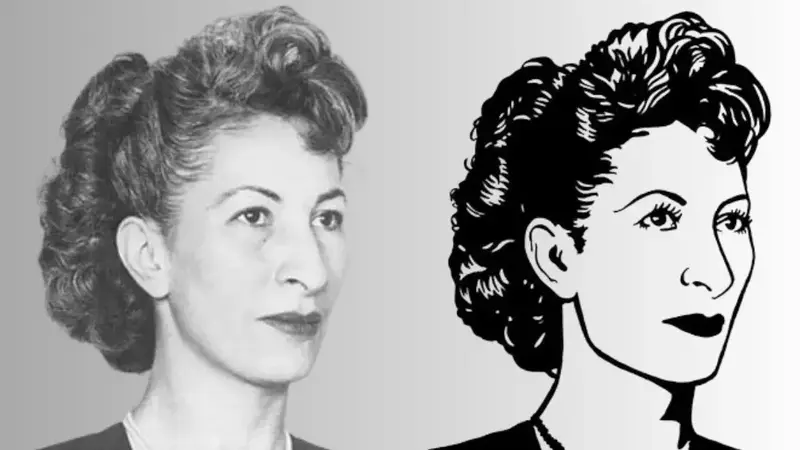Introduction
Luisa Moreno, a key figure in labor and civil rights, significantly contributed to social justice in the United States. Born as Blanca Rosa Lopez Rodriguez on August 30, 1907, in Guatemala City, Moreno’s life and work have left an indelible mark on history. This article delves into her age during key moments in her life, highlighting her achievements and the impact of her activism.
Early Life and Background
Childhood and Education
Luisa Moreno, born Blanca Rosa Lopez Rodriguez on August 30, 1907, in Guatemala City, came from a well-to-do family. Her privileged background provided her with access to education and cultural enrichment, which were not widely available to many women of her time. Moreno was exposed to various social issues from a young age, fostering an early sense of justice and equality.
Formative Years
Growing up in Guatemala, Moreno witnessed significant social and political upheaval, which influenced her worldview. Her early exposure to these challenges ignited a passion for social justice that would define her life’s work. At 19, she had already begun to show a keen interest in social issues, becoming involved in local activism and community organizing efforts.
Relocation to Mexico
In her late teens, Moreno moved to Mexico to further her education. This period was crucial in shaping her future as an activist. She immersed herself in the cultural and intellectual environment of Mexico City, where she connected with influential thinkers and activists. These experiences broadened her understanding of social and labor issues, reinforcing her commitment to advocacy and activism.
Arrival in the United States
Moving to New York City
In the mid-1920s, Luisa Moreno made a pivotal move to New York City at the age of 18. The bustling, diverse environment of New York provided her with a rich tapestry of social and cultural influences that significantly shaped her future activism. Moreno’s exposure to the vibrant immigrant communities and labor movements in the city ignited her passion for workers’ rights and social justice.
Early Involvement in Labor Movements
Upon her arrival, Moreno quickly immersed herself in the labor movement. She found work in the garment industry, where she witnessed firsthand the harsh conditions and exploitation faced by workers, particularly women and immigrants. This experience galvanized her commitment to advocating for better working conditions and fair wages. Moreno’s early involvement included participating in strikes, organizing labor unions, and rallying workers to demand their rights.
Marriage and Relocation to Florida
At the age of 25, Moreno married Angel De Leon, a fellow activist. Together, they moved to Florida, where Moreno continued her labor organizing efforts. In Florida, she became deeply involved with cigar factory workers, many of whom were Latino. She advocated for better working conditions, fair pay, and the right to organize, gaining a reputation as a formidable labor leader.
Rise to Prominence
During her early years in the United States, Moreno’s leadership and organizing skills quickly became evident. By her early thirties, she had joined the Congress of Industrial Organizations (CIO) in 1935, becoming a prominent figure in the labor movement. Her work with the CIO allowed her to organize workers across various industries, further solidifying her role as a key advocate for labor rights.
Key Achievements in New York
- Garment Industry Advocacy: Moreno’s early work in the garment industry laid the foundation for her lifelong commitment to labor rights. She organized strikes and unions, demanding better conditions for workers.
- Cigar Factory Organizing: In Florida, she focused on the rights of cigar factory workers, many of whom were immigrants. Her efforts led to improved working conditions and increased awareness of labor rights within these communities.
- Joining the CIO: At 28, Moreno joined the Congress of Industrial Organizations, marking a significant step in her career. Her involvement with the CIO allowed her to expand her organizing efforts and influence.
- Sleepy Lagoon Defense Committee: By her early thirties, Moreno played a pivotal role in the Sleepy Lagoon Defense Committee in California, advocating for the rights of Mexican American youth wrongfully accused of murder.
Early Activism
Beginnings in New York City
Luisa Moreno began her activism in New York City in the mid-1920s at age 18. Working in the garment industry, she quickly became involved in labor organizing, advocating for better wages, hours, and conditions for workers, especially women and immigrants.
Marriage and Move to Florida
At 25, Moreno married Angel De Leon and moved to Florida, where she continued her advocacy. She focused on organizing Latino cigar factory workers, fighting for better working conditions and fair pay.
Joining the CIO
In 1935, at age 28, Moreno joined the Congress of Industrial Organizations (CIO), expanding her influence and organizing efforts across various industries to promote workers’ rights.
Sleepy Lagoon Defense Committee
In her early thirties, Moreno played a key role in the Sleepy Lagoon Defense Committee, defending Mexican American youth wrongfully accused of murder and raising awareness about their injustices.
Founding El Congreso
At 32, Moreno organized El Congreso de Pueblos de Habla Española in 1939, the first national Latino civil rights assembly, unifying Latino communities to combat discrimination and advocate for workers’ rights.
Key Achievements in Her Thirties
By her early thirties, Luisa Moreno was a prominent labor organizer and activist. At 28, she joined the Congress of Industrial Organizations (CIO) in 1935, organizing workers across various industries. She played a key role in the Sleepy Lagoon Defense Committee in California, defending Mexican American youth wrongfully accused of murder. At 32, she founded El Congreso de Pueblos de Habla Española in 1939, the first national Latino civil rights assembly, to unify Latino communities against discrimination and for workers’ rights.
Here a summary of Luisa Moreno’s key achievements in her thirties presented in a table format:
| Age | Year | Achievement | Description |
|---|---|---|---|
| 28 | 1935 | Joined Congress of Industrial Organizations (CIO) | Expanded her labor organizing efforts across various industries, promoting workers’ rights. |
| 32 | 1939 | Organized El Congreso de Pueblos de Habla Española | Founded the first national Latino civil rights assembly to combat discrimination and unify communities. |
| Early 30s | Early 1940s | Key figure in the Sleepy Lagoon Defense Committee | Defended Mexican American youth wrongfully accused of murder, raising awareness about their injustices. |
This table highlights the significant milestones in Luisa Moreno’s thirties, showcasing her impact on labor and civil rights movements.
Continued Activism in Her Forties
Advocacy During World War II
In her forties, Luisa Moreno continued her tireless activism, particularly during World War II. During this period, she focused on ensuring fair treatment and compensation for Latino workers who were vital to the war effort. Moreno’s work helped highlight the contributions of these workers and pushed for their rights and recognition.
Increased Government Scrutiny
As Moreno’s influence grew, so did scrutiny from the U.S. government. During the 1940s, she faced increased surveillance and pressure due to her political activities and associations. Despite these challenges, Moreno remained steadfast in her commitment to advocating for civil rights and labor rights.
Defending Civil Rights
Moreno continued to be a leading voice in the fight for civil rights. She organized and participated in numerous campaigns to combat discrimination and improve the conditions of Latino workers. Her advocacy extended beyond labor rights to include broader issues of social justice and equality.
Facing Deportation
In the early 1950s, Moreno faced the threat of deportation due to her political beliefs and activism. At the age of 43, in 1950, she chose to leave the United States voluntarily to avoid deportation. She returned to Mexico but continued to support the movements she had been a part of from afar.
Lasting Impact and Legacy
Despite her departure from the United States, Luisa Moreno’s impact continued to resonate. The organizations and movements she helped establish carried on her work, advocating for the rights of Latino workers and fighting against discrimination. Moreno’s legacy is one of unwavering dedication to social justice, inspiring future generations of activists.
Later Years and Legacy
Return to Mexico
In 1950, at the age of 43, Luisa Moreno voluntarily left the United States to avoid deportation due to her political activities. She returned to Mexico, where she continued her advocacy, albeit in a less public capacity. Her departure from the U.S. marked a significant transition in her life, but it did not end her commitment to social justice.
Continued Advocacy
Back in Mexico, Moreno remained connected to the causes she championed in the United States. She supported labor movements and civil rights initiatives, leveraging her extensive network and experience. Though her activities were less visible, her influence persisted through the organizations and individuals she had inspired.
Legacy in the United States
Moreno’s work left a lasting impact on the labor and civil rights movements in the U.S. The organizations she helped establish, such as El Congreso de Pueblos de Habla Española, continued to fight for the rights of Latino workers and against discrimination. Her pioneering efforts laid the groundwork for future civil rights advancements.
Recognition and Honors
Over the years, Moreno’s contributions have been increasingly recognized. Scholars and activists have highlighted her role in labor and civil rights history, ensuring that her efforts are not forgotten. Her story is taught in courses on American labor history and Latino studies, inspiring new generations of activists.
Death and Posthumous Impact
Luisa Moreno passed away on November 4, 1992, at the age of 85. Her death marked the end of a remarkable life dedicated to social justice. However, her legacy lives on, influencing ongoing struggles for workers’ rights and equality. Moreno’s life and work continue to be celebrated as a testament to her enduring impact on social justice movements.
Conclusion
Luisa Moreno life exemplifies dedication and resilience in the fight for social justice. From advocating for garment workers in New York to organizing Latino laborers and defending civil rights, her contributions have left a lasting impact. Despite facing deportation, she remained committed to equality and continued her advocacy.
Her legacy lives on through the organizations she helped establish and the individuals she inspired. Moreno’s story is a powerful reminder of the impact one person can have on advancing social justice. As we remember her, we honor her contributions and draw inspiration from her unwavering commitment to fairness and equality. Contact Us for more details about Luisa Moreno.
FAQs
1. Who is Luisa Moreno?
Luisa Moreno, born Blanca Rosa Lopez Rodriguez, was a key labor organizer and civil rights activist advocating for Latino workers’ rights in the mid-20th century.
2. What were her main achievements?
Moreno joined the CIO in 1935, played a key role in the Sleepy Lagoon Defense Committee, and organized the first national Latino civil rights assembly, El Congreso de Pueblos de Habla Española, in 1939.
3. Why did she leave the U.S.?
She left the U.S. in 1950 to avoid deportation due to her political activities and returned to Mexico.
4. What is El Congreso?
El Congreso de Pueblos de Habla Española was the first national Latino civil rights assembly, aimed at unifying Latino communities against discrimination and for workers’ rights.
5. What was the Sleepy Lagoon Defense Committee?
This committee defended Mexican American youth wrongfully accused of murder, raising awareness and fighting for their legal rights.
6. How did she contribute to labor movements?
She organized workers across industries, advocating for better conditions, fair wages, and union rights, particularly for Latino and immigrant laborers.
7. What impact did she have on civil rights?
Moreno advanced civil rights for Latinos, combating discrimination and promoting unity and workers’ rights, influencing future civil rights progress.
8. How is she remembered today?
Moreno is celebrated as a trailblazing activist whose work in labor and civil rights continues to inspire new generations.
9. What challenges did she face?
She faced government surveillance, the threat of deportation, and opposition to her organizing efforts but remained dedicated to her cause.
10. What is her legacy?
Moreno legacy is one of dedication to social justice, with her work in labor and civil rights leaving a lasting impact and inspiring future activists.


